Major Elements and the Noise Barrier
Coordinate Elements and the Noise Barrier
Variable Elements and the Noise Barrier
Highway noise barriers tend to dominate in the environment since they must be placed close to the roadway, frequently extend for thousands of feet along the right-of-way, and often must be over eight feet (244 cm) in height to be effective. Some barriers in existence today range in height from ten to twenty-five feet (3-7 m) above the road surface. Clearly, the potential for adverse impact may be minimized by utilizing design principles in the planning process, and by a thorough analysis of the site and existing conditions prior to design. This chapter illustrates the relationship between principle and actual circumstance,
The line and form of a noise barrier are its two most dominant features. The line of a noise barrier is expressed as its outline in plan view, and as its top surface in elevation. Both are equally important visually to the motorist and highway neighbor. Long straight lines are monotonous and make a wall seem longer than it actually is. The effect on the motorist is that of being enclosed, as in a tunnel. High walls adjacent to a roadway tend to create anxiety in motorists - they slow down and unconsciously attempt to move away from the wall. The effect of a high, straight wall on the highway neighbor is that of forced enclosure, as if in prison - corresponding negative attitudes about the wall may develop particularly if the wall is bare, without visual interest The designer should consider the line of the noise barrier as a possible adverse visual impact and examine alternatives for reducing this impact.
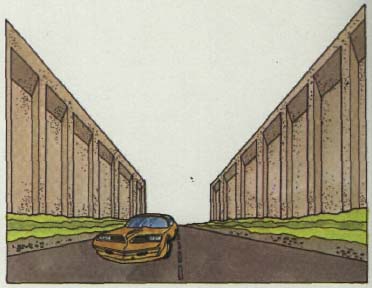
Tunnel effect of high wall
The line of a noise barrier should reflect similar lines of the surrounding environment. In rolling terrain, a straight line seems out of place and attention is drawn to that line. However, in flat terrain, where the horizon is visible as a straight line and the highway is straight, a straight line in a noise wall may be appropriate. A uniform top line of a wall would be appropriate in this case. Where horizontal lines are evident in nearby structures, a horizontal line would be suitable in a noise wall. In an urban situation, where the horizon is composed of alternating heights of buildings, an appropriate top line of a wall might vary in height, as a reflection of the lines on the horizon
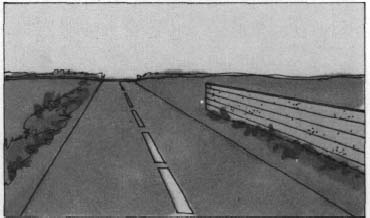
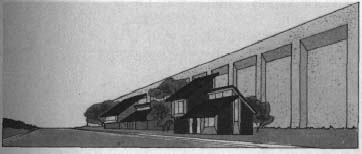
Forced enclosure, a prison-like effect
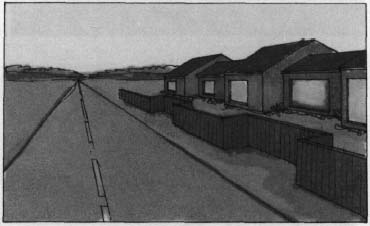
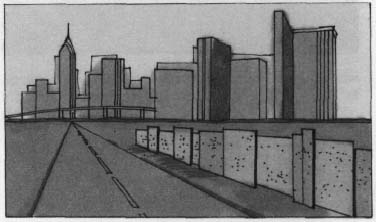
Lines which reflect similar lines in the surroundings
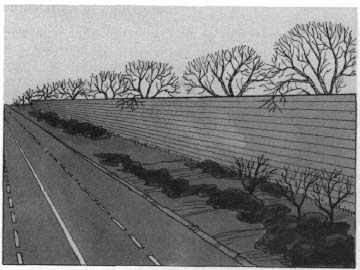
A strong horizontal line
Horizontal lines tend to make an object appear longer and lower. Vertical lines have the effect of added height and tend to make an object appear more narrow. Noise walls tend to be long and high; therefore, both horizontal and vertical lines, if used improperly, may emphasize undesirable features in a wall. Horizontal lines are difficult to utilize in rolling terrain and should be avoided in this situation. Vertical lines should be avoided on extremely high walls. Combinations of horizontal and vertical lines may be effective where extreme height is a visual problem.
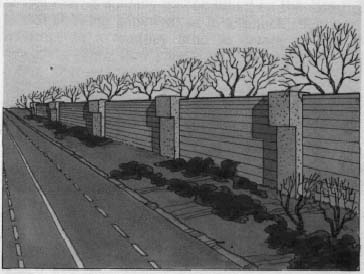
Addition of vertical elements breaks up strong horizontal.
Noise walls are necessarily long and predominantly horizontal. The visual imbalance caused by this situation can be reduced through design. The introduction of a vertical element is the key to proper visual balance. A vertical line should be distinct and massive enough to register as such. Noise barriers, as strong horizontals, need a correspondingly strong vertical for asymmetrical balance. Strong verticals may be designed into a wall, through the use of pilasters, which further serve as structural support.
Plantings can be effective means of emphasizing vertical lines in a noise barrier. Columnar trees can be used even where space is limited. The use of vertical lines in the form of trees or through wall design should be as an accent, a balance with the horizontal. One should not replace predominantly horizontal with predominantly vertical lines. Care should be taken to achieve a balance between the vertical and the horizontal lines in noise barriers.
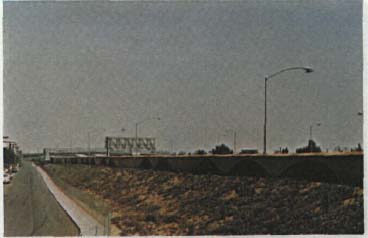
A strong horizontal line evident in a noise wall.
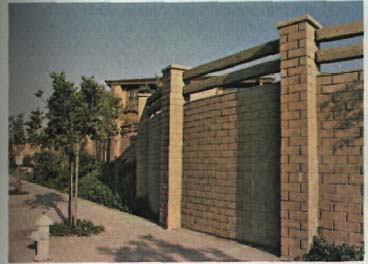
Pilasters serve as vertical elements in this wall.
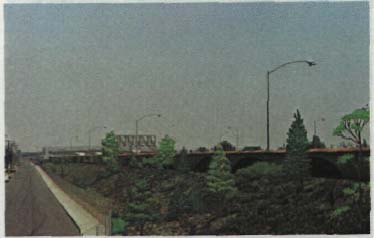
Apparent horizontal line diminished through the introduction of vertical elements in the form of plant materials.
A return on a wall
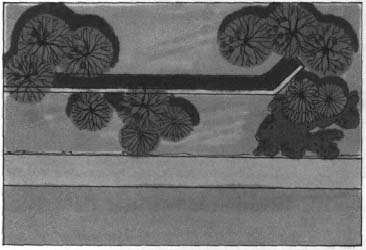
Plan view
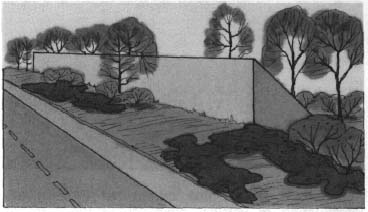
Perspective view
Noise walls which begin and end abruptly and consist of straight, unbroken lines often appear to be discordant elements in the landscape. These should appear to be a part of the highway scene wherever possible, and not give the impression of being placed as an afterthought. Walls should begin and end in a natural transition from ground plane to the desired height. Where space allows, the best transition is through the use of an earth berm or by tying the wall into the natural hillside. The line of the wall then appears to originate from the landscape. Abrupt endings on walls should be avoided; if at all possible, a return should be planned, which carries the line of the wall away from the eye of the viewer. This reduces the unpleasant, unfinished look which generates the impression that the wall might collapse at any moment. This may further be avoided by either a gradual tapering of the wall to a point near the ground or by stepping the wall in even increments until a point is reached where the wall is no longer visually dominant. Where possible, walls should tie into existing structures such as bridge abutments, retaining walls, etc., in order to achieve continuity of line.
Wall ending in berm
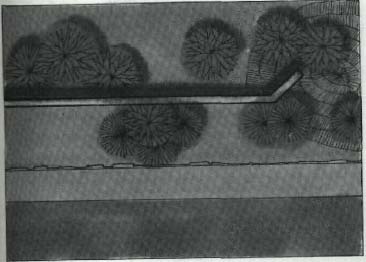
Plan view
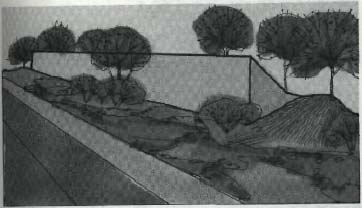
Perspective view
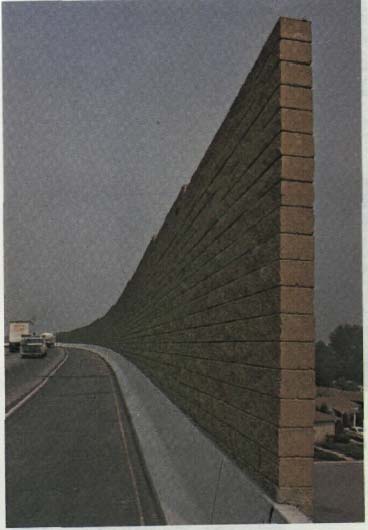
Avoid abrupt endings on wall
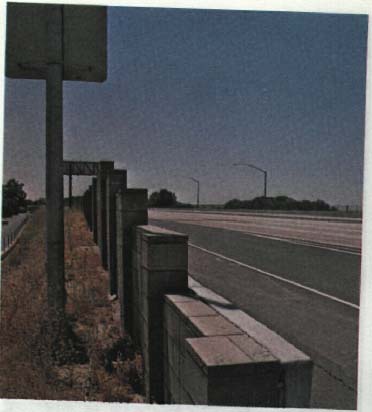
A wall which steps down gradually reduces visual impact.
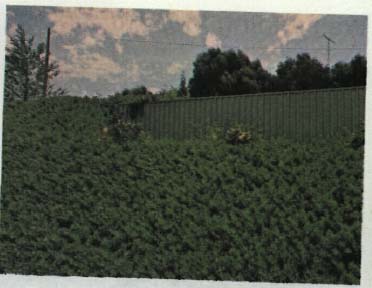
An ideal situation - tying a wall into a natural hillside or ...
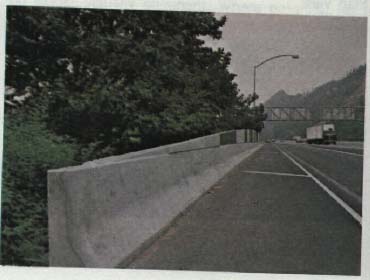
Gradual tapering of a wall
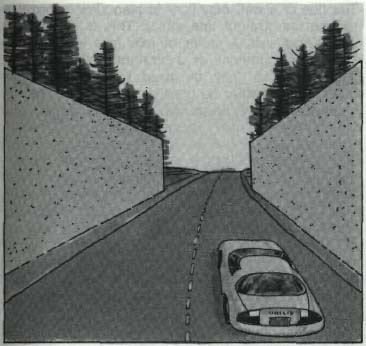
Undesirable: restricted view
An effective method of reducing visual impact is through multiple walls, arranged in tiers, with setbacks of several feet or more between successive tiers. This has the effect of reducing the apparent height of the wall; the tunnel effect, a tight constricted feeling of enclosure, is minimized when the top of a wall recedes from view rather than encroaching upon it.
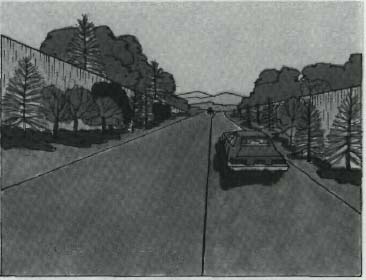
Desirable: walls which step back open up the view
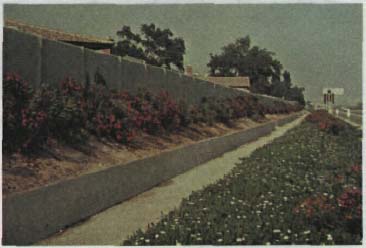
A castellated wall
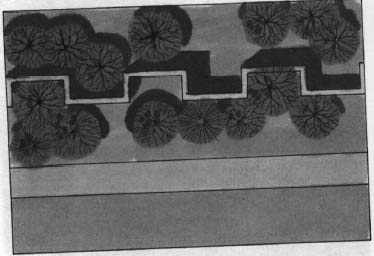
Plan view
The line of a wall may vary in plan view in order to reduce the straight line effect. This is known as a castellated wall. A series of jogs in a wall serve to break the monotony of a straight wall and create pockets which may be used for plantings. The breaks may further be used as transition points for change in texture, color, or wall height. The line may vary in a curvilinear manner to produce a serpentine wall, which likewise creates visual interest in a wall, and provides the opportunity for planting pockets. Serpentine walls should be composed of large arcs consistent with the relatively massive scale of the wall and the highway. Both serpentine and castellated walls may be constructed with two or more tiers to create visual interest and further relieve the constricted feeling associated with a high wall. An added advantage in serpentine and castellated walls is free-standing structural strength, a requirement in noise barriers.
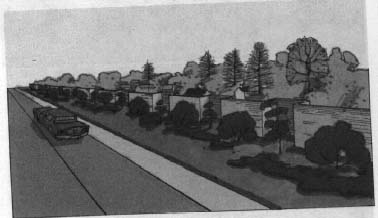
Perspective view
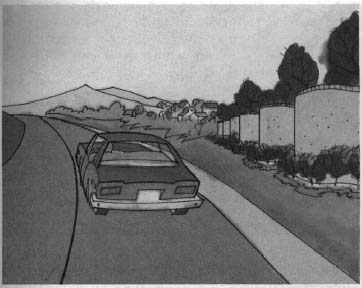
Serpentine walls
A serpentine wall
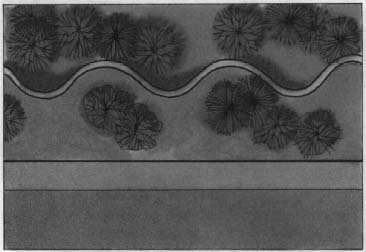
A serpentine wall

A serpentine wall

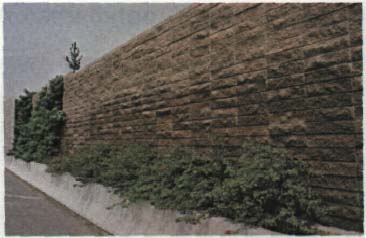
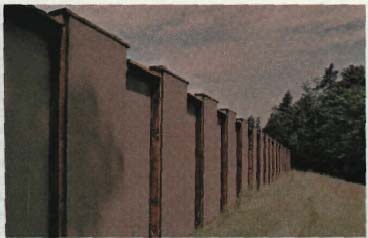
A wall which varies in plan view, to reduce the straight line effect, and provide visual interest
Planting pockets created by jogging a wall. They are also used as transition points for textural change.
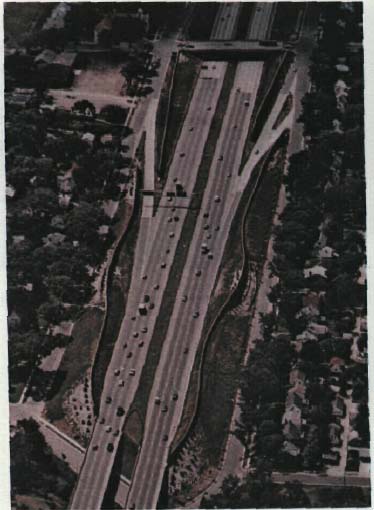
A serpentine wall
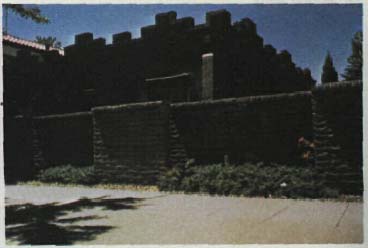
The variation in this wall reflects character of building.
Plantings also may be used to break an undesirable line in a wall. Trees in front of a wall soften the harsh lines; the eye perceives the form and outline of the trees as one with the line of the wall. Vines allowed to grow over a wall will likewise soften an otherwise highly visible hard line. Tree groupings should alternate on both sides of a wall - the viewer becomes less aware of the line of the wall since it becomes part of a composition of forms, rather than a separate element.
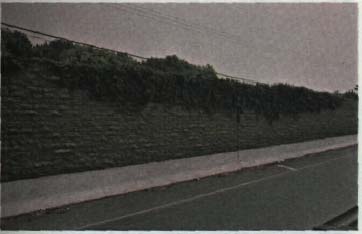
Vines soften the hard lines of a wall.
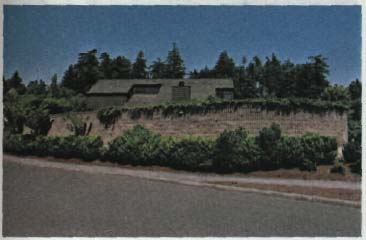
Vines and shrubs used in combination to soften the lines of awall
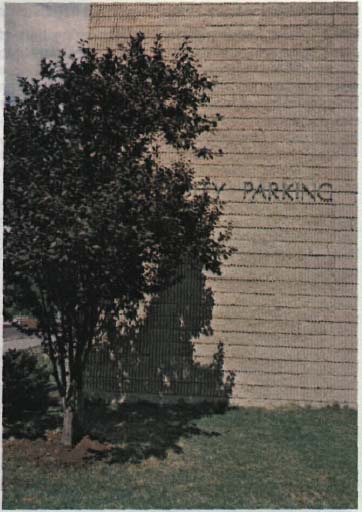
A tree used to soften the hard edge of a wall reduce the dominance of this wall.
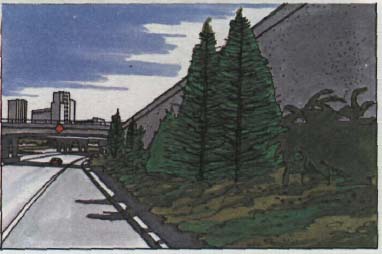
Shrubs soften the transition between wall and ground plane.
Earth berms, as the most natural appearing type of noise barrier, should have a line and form similar to a natural hillside. Slopes should approach a 3:1 ratio wherever possible, with transitions in the form of an S curve. Slopes that are steeper than this, with sharply angled transitions, are erosion prone, difficult to plant and maintain, and appear manmade. Rather, one should get the feeling that the berm is a natural landform. Where space allows, the line of an earth berm should vary to further create a natural look. Several berms can be overlapped to create pleasing effects while maintaining noise abatement capability. Plantings should be used as vertical-elements on berms, which are distinctly horizontal forms.
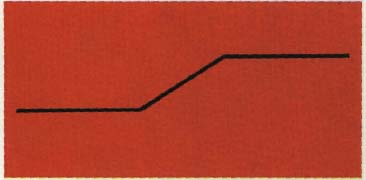
Angle section
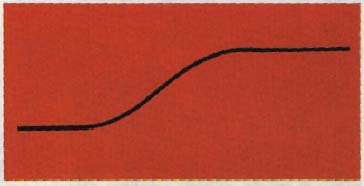
S Curve section
Earth berm which varies in plan
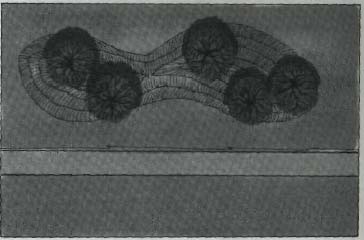
Plan view
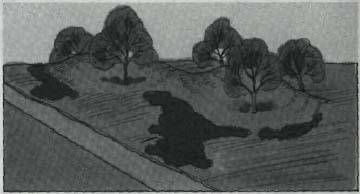
Perspective view
Plan view
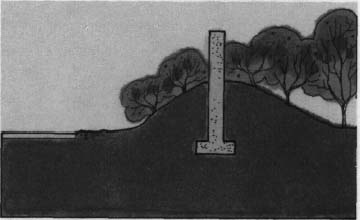
Perspective view
Berms may be used in an alternating pattern with walls to break up the undesirable line of a wall. Berms may also be built in front of a wall to reduce the apparent height of the wall. The straight line effect may be diminished by varying the height of the berm in relation to a constant wall height. Noise barriers of this type should always end in a berm that approaches the height of the wall in order to visually tie the barrier into the landscape.
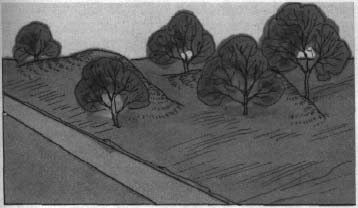
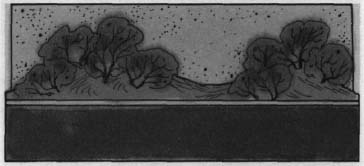
Earth berm which varies in height combined with wall
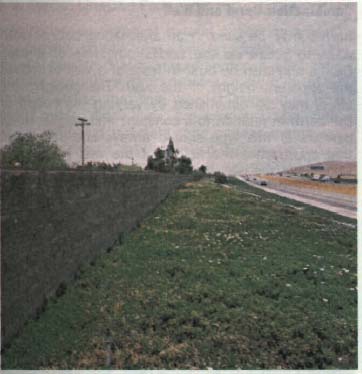
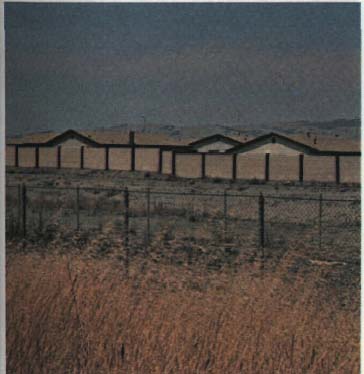
Wall colors which harmonize well with other colors in the environment
Colors evoke psychological responses. Harmonious colors tend to soothe; contrasting colors tend to attract the eye; and clashing colors irritate. A noise barrier placed along the highway may evoke similar responses in the motorist, depending upon the colors chosen. The motorist should be directed past a barrier with as little visual disruption as possible, because the primary attention of the driver should be on the road ahead and local traffic conditions. The colors chosen for the barrier should reflect and harmonize with the predominant colors of the highway environment in which it is placed. Barrier walls are structures placed in the natural environment. As such, they should not attempt to match the color of trees, grass, or shrubbery because they are not related to such natural features by form. The use of green as a color for such obviously manmade features often reduces visual attractiveness. Rather, harmonious colors should be utilized. The so-called earth colors - browns and grays of various tones - when used on structures in the landscape, help to blend the structures into their environment. Structures which utilize these colors seem to belong to the landscape - they appear to be part of the landscape, rather than an unharmonious element added as an afterthought.
Residents who live adjacent to a barrier become very aware of its existence as part of their environment. In many cases, the barrier results in an interruption of the view and may create an uncomfortable feeling of forced enclosure. In this case, the use of harmonious colors will help to minimize the conscious awareness of the barrier, and will help to blend it into the surroundings.
In urban situations, where a barrier abuts on public pedestrian spaces, color may be utilized to other advantages. Bright, vivid colors tend to create a festive atmosphere; in malls, plazas and other public spaces, the use of contrasting colors helps to create visual interest, cheerfulness, and excitement. In such situations, the use of wall graphics can be both appropriate and attractive, Graphics can be used to convey a simple message or to identify a place with effective and pleasant results.
Proposed graphics: (State of Minnesota)
Color interest and variety may be achieved through the use of plant materials instead of by direct application on barriers. The added advantage of plantings is in seasonal variation of color. Plants which change color in spring, summer, and fall, when used in conjunction with a barrier, will impart a seasonal variation in the barrier as well. In most cases, the barrier should be of a neutral color which blends with the environment, rather than attracting attention.
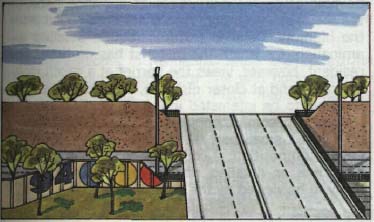
At an overpass
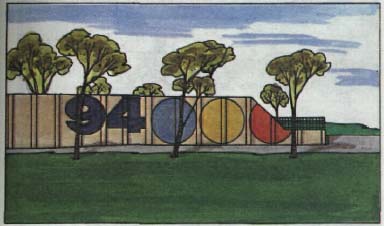
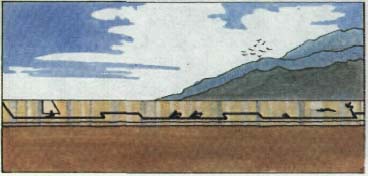
Adjacent to a beach recreation area
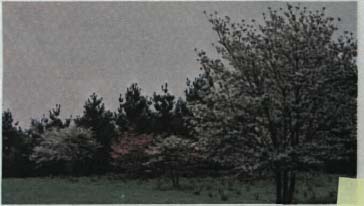
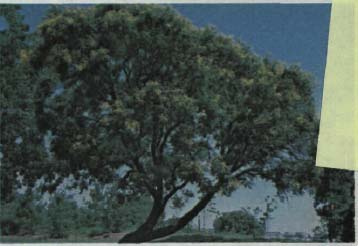
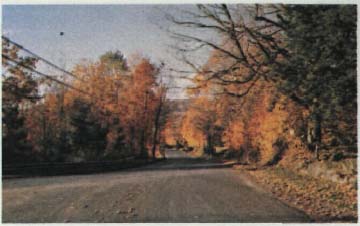
Seasonal color provided by plant materials
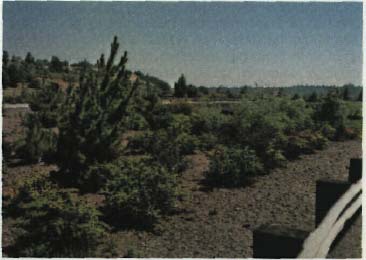
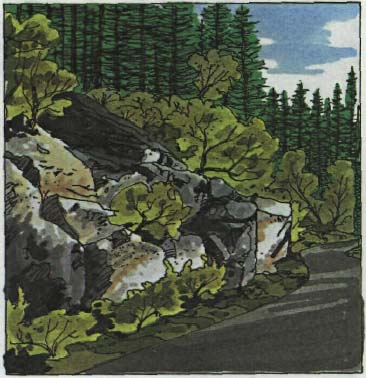
Bold textures along a highway
Textural variations account for much of the visual interest in our daily lives. The use of texture on noise barriers helps to create a pleasant variety for both the motorist and the resident. The requirements of each are different, however, and must be treated differently for optimum results.
A motorist views a barrier at speeds of up to 55 mph and has little opportunity to examine details. Most details flash by in a blur.
To be effective, textures along the highway need to be bold or coarse and visible at a glance because the motorist's attention should not be diverted from the highway. Detailed textures require detailed examination, for which the motorist has no time. The resident, however, views the barrier at a much slower speed, and at closer distance. The pedestrian has the time to be interested in detail. Bold textures in this case become monotonous; the viewer concentrates on a small part of the scene rather than the entire composition. Textures should, therefore, be of a fine or detailed nature when the barrier is likely to be viewed by the pedestrian.
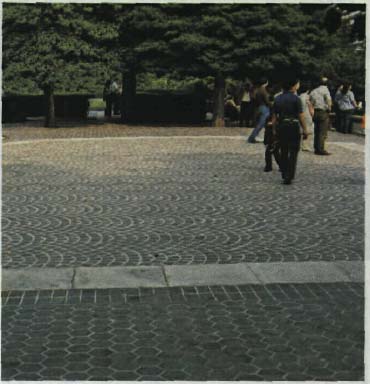
The textural detail of this paving is suitable for viewing at the pedestrian scale.
Each type of noise barrier presents the opportunity for textural variation, which will aid in public acceptance of the barrier. Textural variation in earth berms can, perhaps, be best accomplished through the use of plantings. Plantings on the highway side should be arranged in large groupings or masses of a single plant type, size, or color. Plants with large leaves represent the coarsest textures and should be used "en masse" where this texture is desired. Massing should be in irregular, free-form patterns of varying size, rather than equally spaced and repetitive. Patterns may be repeated, but should be large enough that the repetition is not obvious from a single viewpoint.
Berms adjacent to residential areas and pedestrian traffic should employ both fine and coarse texture to provide visual interest. Plant masses may be smaller; fine textured plants can be seen and appreciated by the pedestrian individually. Grass, the best natural ground cover, is a fine textured plant which provides a good balance when used with coarser trees and shrubs in a planting. Where possible, plantings on a berm should consist of native species commonly found in the area. Trees and shrubs on a berm, which are similar to adjacent plantings, will help to achieve continuity between the berm and the surrounding environment.
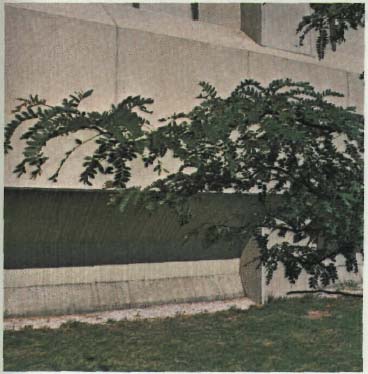
Fine texture in plant materials
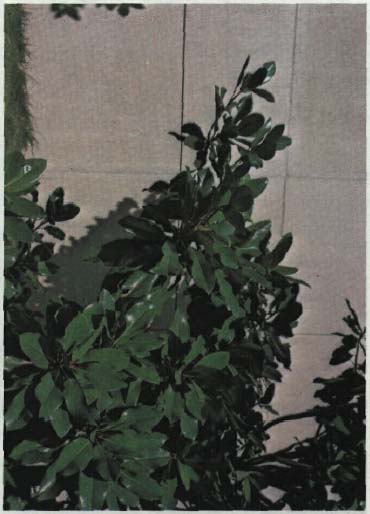
Coarse texture in plant materials
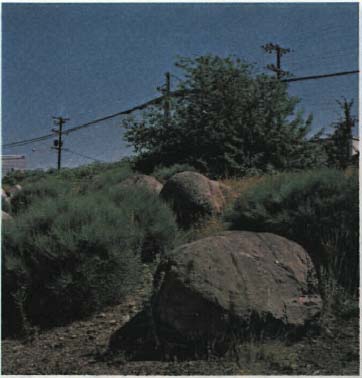
Coarse texture on a berm, created with rock and plant materials
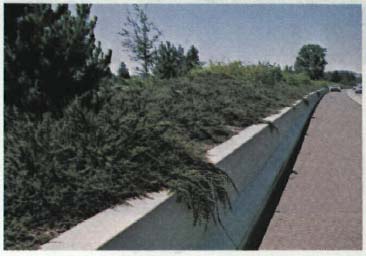
Fine textured plant materials on a berm
Rock and gravel may provide textural interest but should be used in combination with plantings to avoid the somewhat artificial look created by gravel alone. Gravel is relatively maintenance free and provides a good contrast when used with plantings, but it appears cold and stark without the balance of plant material. Large rocks provide good coarse textures for earth berms.
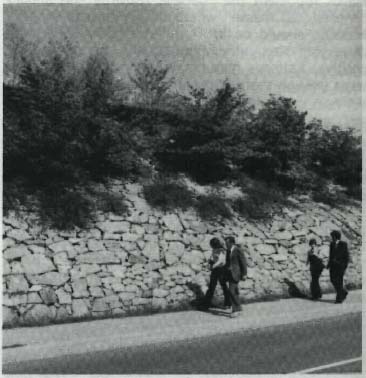
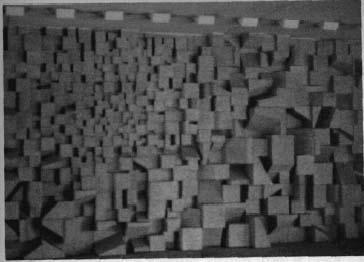
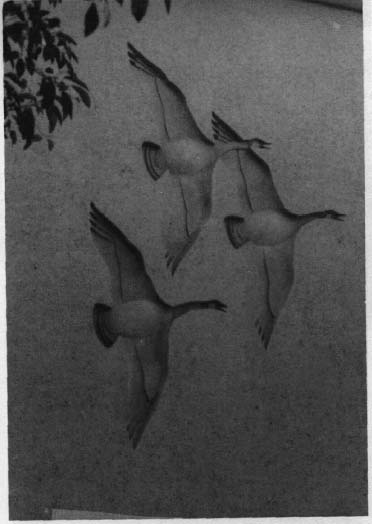
There are unlimited possibilities for achieving texture in concrete.
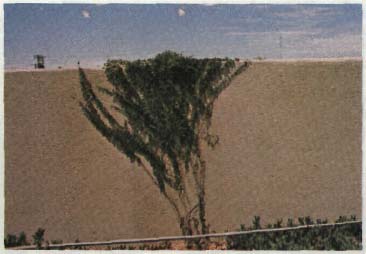
Fine textured stucco.
Walls present good opportunities for textural treatment. Texture should be used wherever possible for maximum visual potential. Cast-in-place and precast concrete has great flexibility for variations in surface texture. Texture may be created during the casting process or applied afterward. Stucco, primarily using a rough trowelled finish, has been used effectively for highway noise barriers. The possibilities for the use of stucco as a texture are quite varied, although the finish must be quite rough to be effective visually. The use of this material should be confined to localities where stucco is a common building material in order to ensure visual continuity.
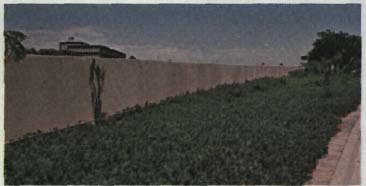
. . . cannot be distinguished, even at this relatively short distance.
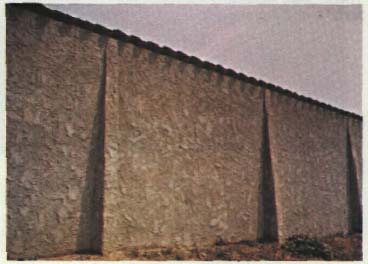
Coarse texture in a stucco wall is visible at a distance.
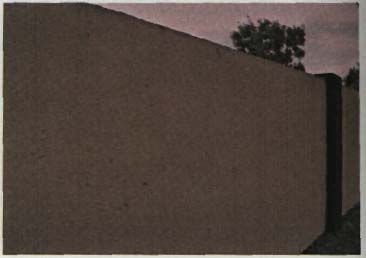
A fine textured broom finish is difficult to see at a distance.
Exposed aggregate finishes create interesting textures, particularly where coarse aggregate is used in the mix. This is also effective when used alternately with other textures. The added advantage of exposed aggregate is low light-reflectance which helps to reduce the visual impact of the barrier. Wall colors can be varied, depending on the color of the aggregate.
Shadows created in the forming process help to create texture and break up the visual monotony of a plain wall. These may be created through the use of rustication strips placed in the forms, or by variation in the form itself. Horizontal overhangs or vertical jogs in a wall should be deep enough to cast a discernable shadow visible from a distance.
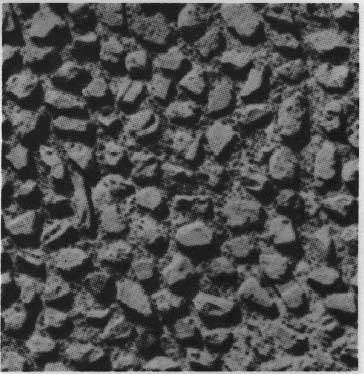
Exposed aggregate surface on a concrete wall
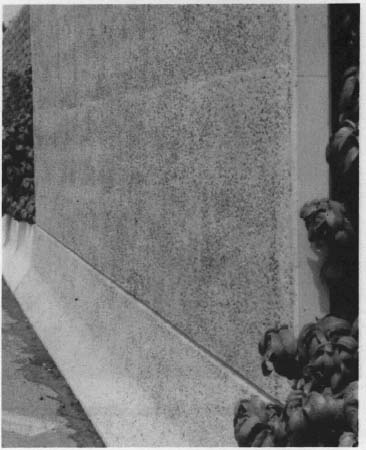
Exposed aggregate surface treatment carried through on New Jersey type barrier
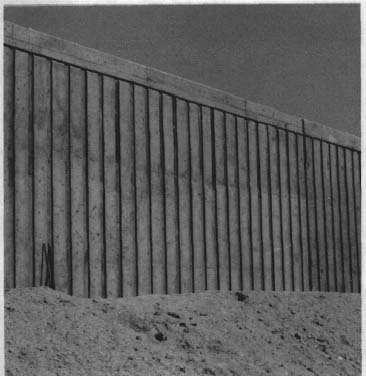
Shadow lines created in the forming process
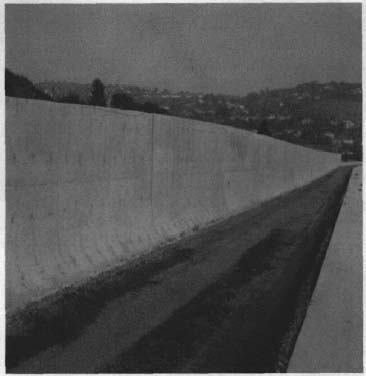
Without a visible texture, a wall appears plain and unattractive.
Board-form textures on a concrete wall create the look and visual appeal of wood. To be most effective, boards must be rough surfaced. By alternating boards of varying thicknesses, the effective viewing distance of this surface is increased due to the shadows created.
Form liners are available commercially in a variety of patterns. New patterns and liner materials are constantly being developed. Some liners are relatively expensive and may be used over and over while others can be used only once. The form liner is a highly effective method of creating texture in cast concrete, and the possibilities for textural variety are near endless. Almost any common type of building material, including wood and brick, may be simulated in cast concrete, a less expensive, more durable, and widely available material.
Perhaps the most visually effective method of creating texture in concrete is by utilizing a combination of methods and textures, particularly for long and high barrier walls. Interesting effects may be obtained by varying the texture of a long section of wall; however, textures should be compatible and similar in contrast. Rarely should more than two textures be used on the same wall; the designer should avoid alternating textures in even, repetitive patterns.
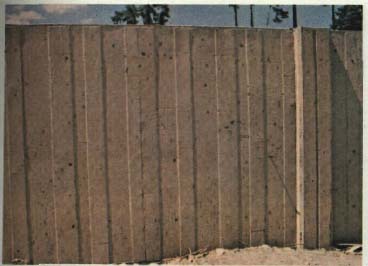
Board form texture on a noise wall
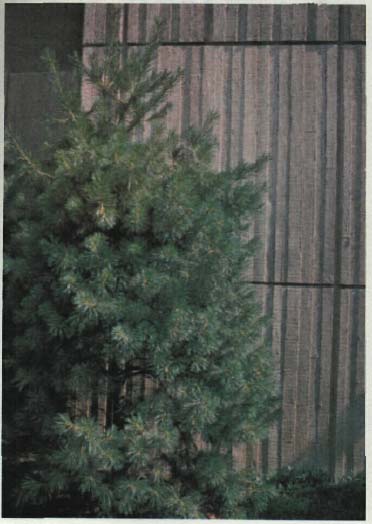
Board form texture and fine textured plant materials
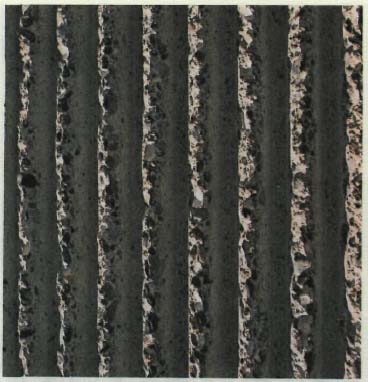
Textures created by form liners . . .
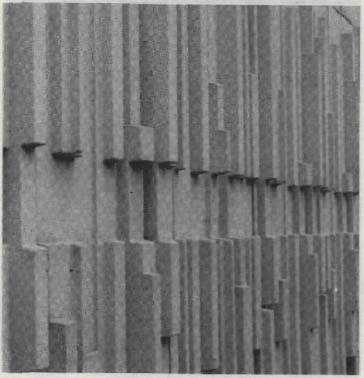
. . .used in the casting process
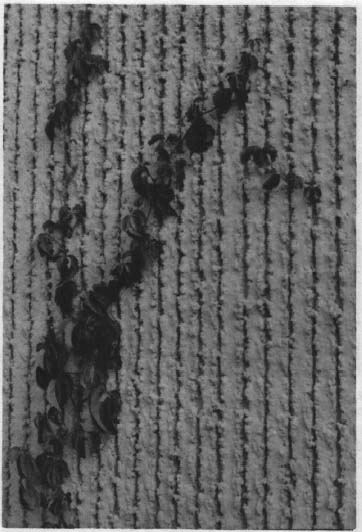
Texture in concrete and plant materials
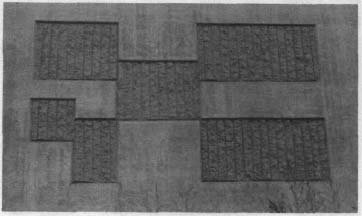
Texture created with reinforcing rod used in the forming process
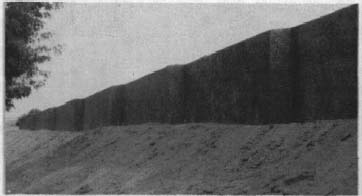
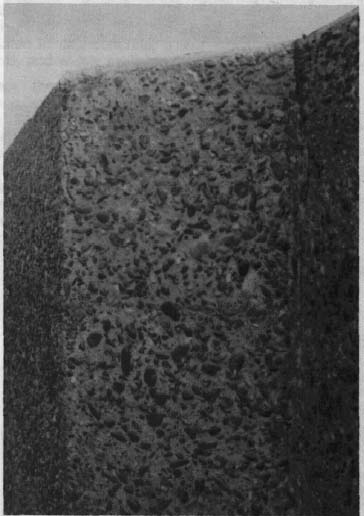
A combination barrier with an exposed aggregate surface treatment. The relatively fine texture is difficult to see at a distance.
Combinations of berms and walls are effective for noise control, particularly where height requirements will not be reached by use of a berm alone. Textural interest may be created through treatment of the wall surface, through the use of plant materials on the berm, or both. The residential side of a barrier, when likely to be viewed by pedestrians, should incorporate both fine and coarse textured plant materials. Coarse textured plant materials should be utilized on the highway side in mass plantings, alternating with fine textured grasses and ground covers for maximum effect. Plant masses should vary in height to further enhance the visual effect of the variation in textures. If a wall is placed on top of a berm, the viewing distance is increased, and textural treatment on the wall surface must be coarse in order to be seen by the motorist. Walls may also be used to retain earth berms; texture in this case is an important consideration since the wall is placed closer to the viewer. Often New Jersey type barriers are used as retaining walls for earth berms; these may be textured through sand-blasting or by creating an exposed aggregate finish in the forming process.
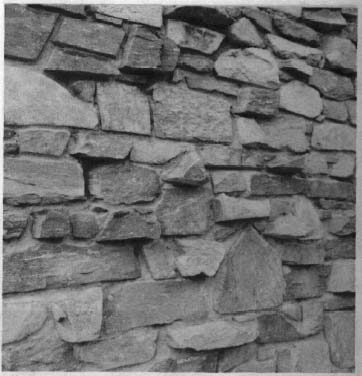
Mortared stone
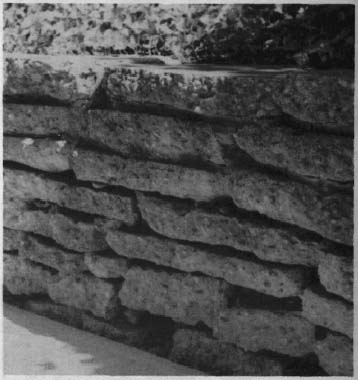
Broken concrete used as a retaining wall
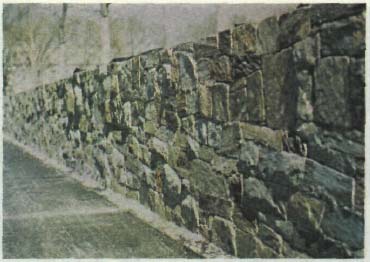
A coarse textured stone wall.
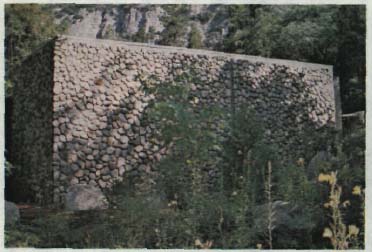
Natural texture helps to blend a structure into the environment.
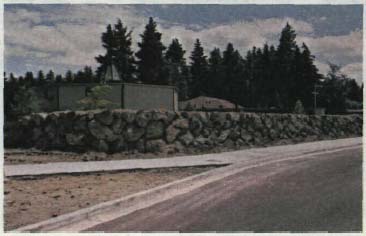
Dry stone used in combination with a berm for noise abatement
Noise walls have been constructed of a variety of materials in addition to cast-in-place concrete. The following materials may be used successfully to create texture, and thereby increase visual quality in noise barriers.
Stone exhibits a naturally rough, coarse texture. Visual interest may be created by the use of stone applied as a facing material to concrete or concrete block walls. Stone is particularly effective when the mortar joints are deeply raked to produce a three-dimensional look, due to the shadows which result from this method. Stone has also been successfully used as a dry wall and may be constructed as a freestanding wall or as a retaining wall for earth berms. This method is useful where right-of-way is at a minimum, and available space limitations prevent the use of an earth berm alone. The natural appearance of stone blends well with the highway environment and with the rural and semi rural landscape. Where this material is readily available, consideration should be given to its use. Broken concrete from roadway excavation has been used successfully for retaining walls and is an inexpensive, available material which resembles natural stone. The added advantage of stone is in the variations of color that are possible through the use of different types of stone. Rough stone is low in light-reflectance and tends to change in apparent color with the time of day, adding to its visual interest.
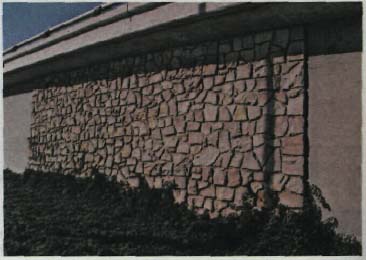
Variations in color of stone produce interesting visual effects.
Gabions, essentially wire baskets filled with stone, have been used for noise walls in Canada and are well received by residents, who like their natural appearance. The gabions may be stacked in various ways to create a wall. When viewed from a distance, the wire cage tends to become invisible, and the natural texture of the rock becomes dominant. Color variations may be created through the use of different colored rock, depending on local availability. Gabions also have proven to be relatively maintenance free and extremely durable.
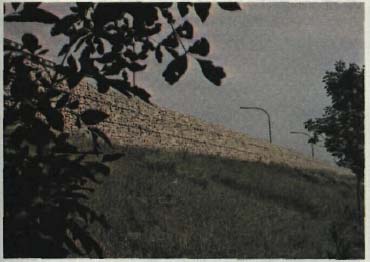
A gabion noise wall
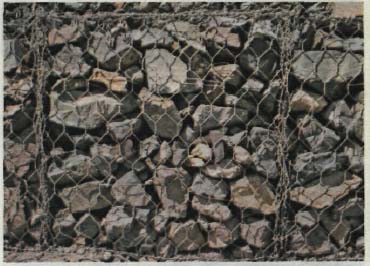
Gabions are essentially wire baskets filled with stone.
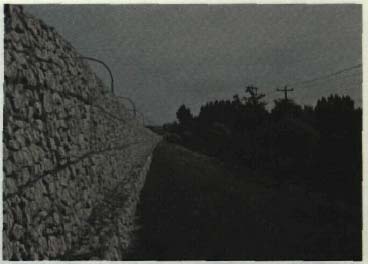
Note how color of wall changes with time of day
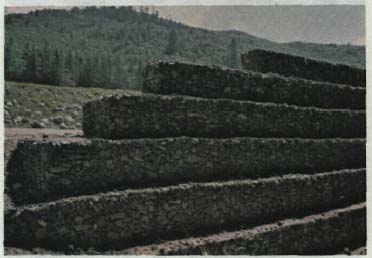
Gabions may be stacked in a variety of ways to construct a wall.
Brick may be used for noise walls, although the detail of the bonding pattern is fine textured and is, therefore, best viewed at close distance. The fine texture of brick is indistinguishable by a motorist moving at a high rate of speed. Therefore, for highway use, texture should be created through other means, such as with plant materials, particularly on the highway side of the wall. Deeply raked joints help to create shadows which increase the effective viewing distance of brick. Textural shadows may also be created by offsetting bricks in random patterns, or by the use of pilasters, copings, or other variations in the line of the wall.
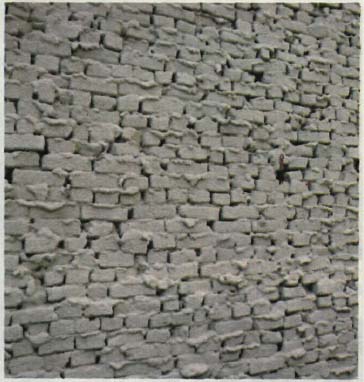
Unusual texture in a brick wall
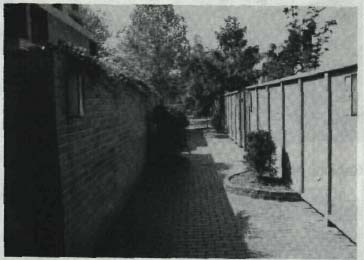
A suitable distance from which to appreciate texture in brick
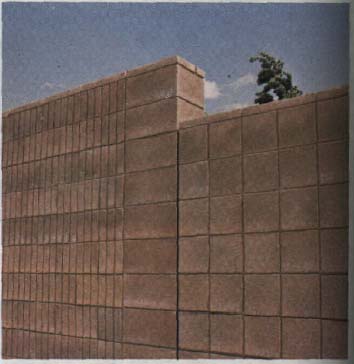
This finely detailed pattern . . .
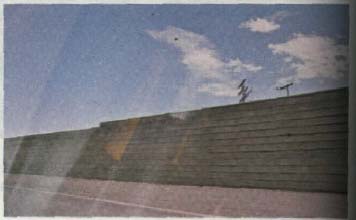
. . . means nothing to a motorist passing by at a high speed.
Concrete block is available in a variety of textures. Split-face block is particularly useful for noise walls, since the rough surface texture resembles stone and is visually attractive. Slump blocks also provide a rough surface texture visible from a distance. Standard or split-face blocks may be offset to form shadows. Blocks of varying thicknesses may also be used for this effect. A rough texture can be achieved with split blocks by using the jagged edge as a surface. Scored blocks with recessed grooves create interesting shadow effects which read as coarse texture. Each of these blocks may be specified in a variety of colors. The darker grays and browns more closely resemble other colors in the environment and tend to blend well when used in noise walls.
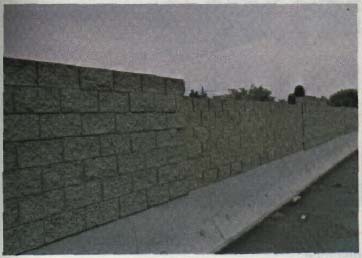
Split faced concrete block used in a noise wall
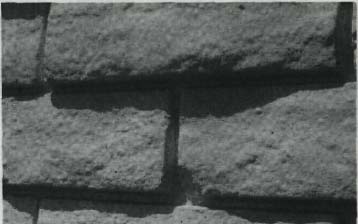
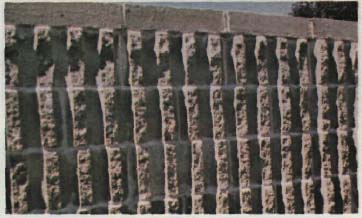
Textured blocks create shadow effects.
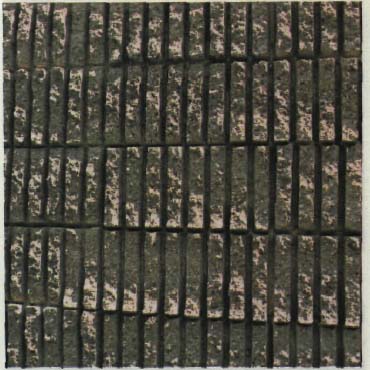
Scored concrete block
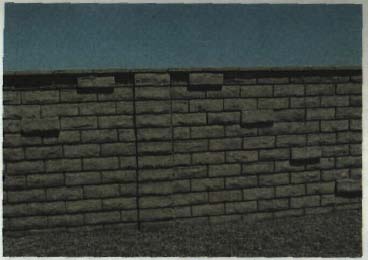
Slump blocks offset to create shadows.
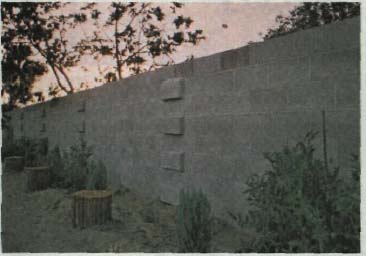
Concrete blocks of varying thickness to create shadows
Wood exhibits a natural surface texture when rough sawn. Alternating thickness of planks placed either vertically or horizontally helps to make the wood texture visible at greater distance. Plywood has been used in several noise walls and is quite durable when treated properly. Rough sawn plywood paneling is attractive, but it is also relatively fine textured. The texture of wood is best viewed at close range; therefore, wood battens or other means to create shadows are necessary on a wood wall which is to be viewed from the highway or from a distance on the residential side.
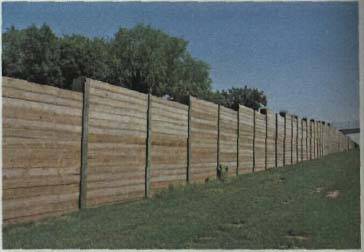
The natural texture of wood is difficult to see at a distance.
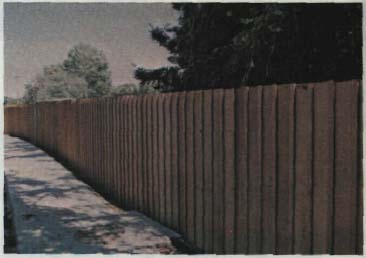
Wood battens used to create texture in a wooden wall
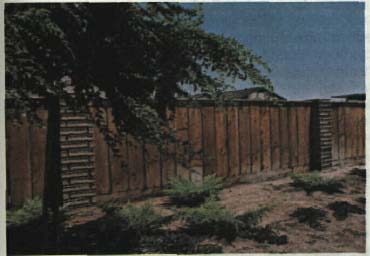
Natural texture of wood used in combination with concrete block
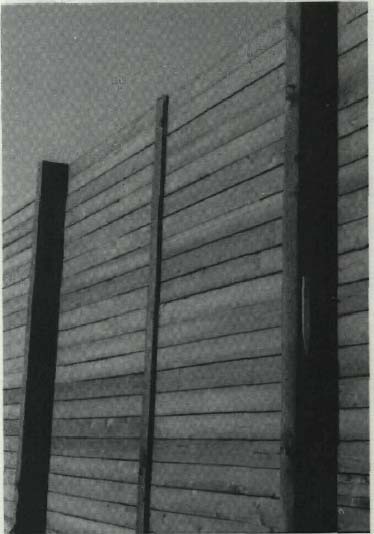
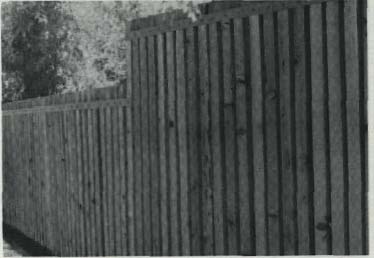
Shadows created by vertical posts increase texture.
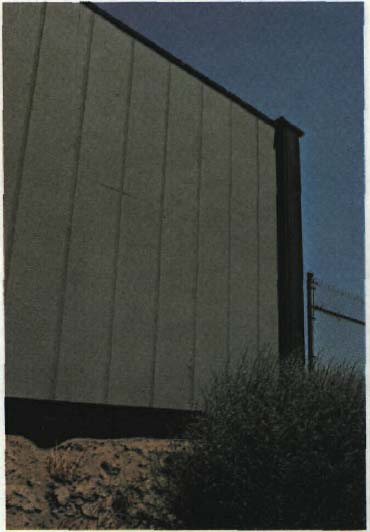
The rough sawn texture of this plywood panel. . .
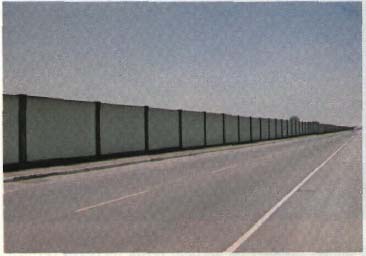
. . . cannot be seen at a distance.
Texture in metal walls is created by the corrugation of the metal sheets; many of these resemble wood from a distance. This effect may be heightened through the use of natural wood colors for metal walls. Shadows, created through the use of copings, offsets, etc., help to provide textural interest to otherwise plain walls.
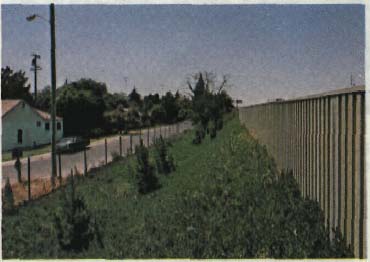
A textured steel corrugated wall which resembles wood
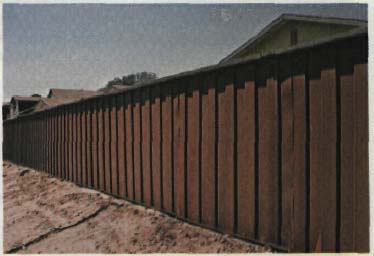
A Corten steel corrugated wall which rusts to a natural wood color
Combinations of materials may provide textural interest. Concrete blocks of different surface textures may be alternated although care must be taken to avoid an obvious repetitive pattern. Wood and concrete may also be alternated to create an interesting wall design. A conscious design effort is needed in order to avoid the checkerboard effect of alternating patterns of texture on a wall. Textural variation is best accomplished at some point of change in wall height or configuration. Arbitrary changes in texture along a straight wall appear to be without purpose and tend to detract from the appearance of the wall.
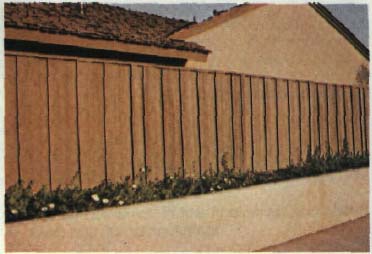
Combination wood and concrete wall. Note similarity between wall colors and house colors.
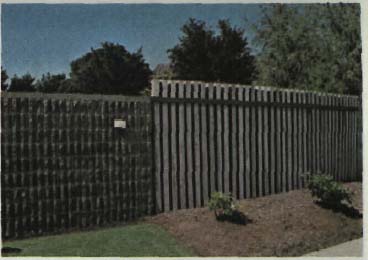
A combination of materials which produces an interesting wall
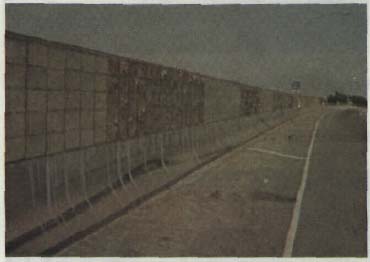
Undesirable contrast
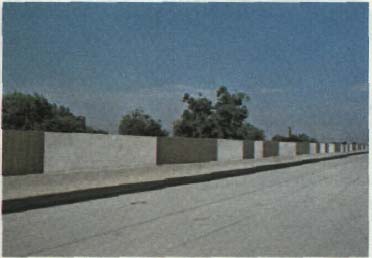
Between adjacent colors
Between wall and surroundings
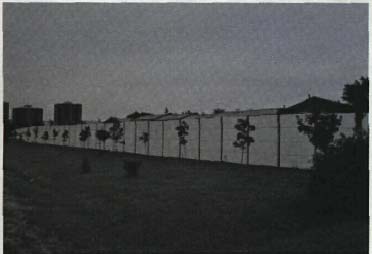
Avoid repetitive, equally spaced tree plantings.
A noise barrier may contrast with its surroundings by its line, form, texture, or color. In an urban setting, adjacent to pedestrian traffic, a higher degree of contrast may be appropriate, particularly where a festive, active human activity is desired or exists. In residential areas, the barrier should be unobtrusive and, therefore, low in contrast. On the highway side, a barrier should blend rather than contrast with the surroundings since high contrast is distracting to the driver. Plantings can either increase or decrease contrast of a noise barrier. Plantings that are similar in form, color and texture to other native plants present in the area help to reduce the contrast of a noise barrier. Plantings that are unique in form or color or that are dissimilar to native plants in an area tend to increase contrast. Likewise, to decrease contrast, plantings should be arranged in informal, natural groupings rather than in obvious, equally spaced, patterns.
Contrast may also be increased or decreased via color of the barrier itself. Where high contrast is desired, lighter colors or wall graphics may be used effectively. Darker, earth colors tend to reduce contrast. The designer should examine the site and surroundings in order to determine the predominant natural colors and choose similar or harmonious colors for the noise barrier where low contrast is desired.
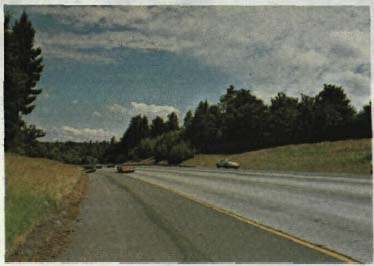
A noise barrier which is low in contrast and seems to blend with its surroundings
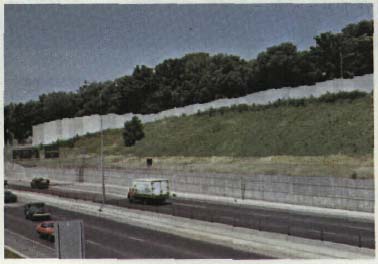
Excessive contrast. A darker color would blend this barrier into the background trees.
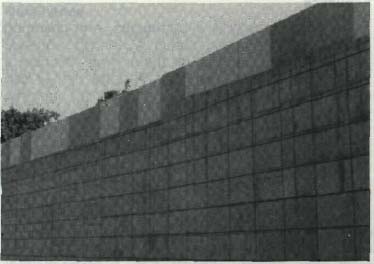
High contrast between adjacent materials
Travel on a highway is a continuous, ever-changing experience of vision and motion. A planned sequence of events creates interest for the moving observer; a static event creates monotony, A noise barrier can create a pleasant visual experience for the motorist through a progression or planned sequence. The transition from ground plane to maximum barrier height should be a sequence of gradually increasing steps or a continuous sweeping line to help create this effect. A sequential experience may be created through the arrangement of plantings, by a gradual increase in height of trees and shrubs. Plant masses can be used to define a space by becoming, in effect, the walls of the enclosure. Varying the position of these masses with respect to the road creates a succession of confined and relatively open spaces. This pleasant feeling of motion and rhythm imparted to the moving observer tends to dramatize the experience of passing through the space. A planned sequence can be a pleasurable experience for the pedestrian also, but it must be designed at a scale consistent with the slow viewing speed of the observer. Individual enclosed spaces of an intimate scale can be created for pedestrian interest and enjoyment through integration of walks, noise barriers, and plant materials. The pedestrian or motorist should be confronted with a series of different spaces (each designed to be separate, yet interconnected) as he or she moves through the entire composition. In this way, the observer experiences the individual spaces but also is aware of his or her progressive movement from one to the other.
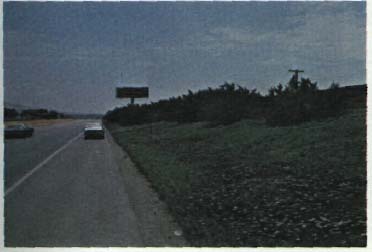
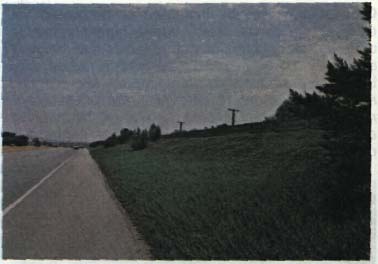
Plantings on a berm, used to open and enclose the visual space along a highway and help create a pleasurable sequential experience for the motorist
The highway is often a strong visual axis which tends to direct the view forward in a straight line. A noise barrier of substantial length tends to reinforce this axial view, as an element of enclosure and enframement. However when a high barrier is placed on only one side of a highway axis, a visual imbalance exists which is distracting to the motorist. The visual axis should be balanced in some way on both sides of the central element. Visual balance may be achieved by similar elements on either side or by dissimilar elements of equal dominance. A grouping of trees can effectively balance an axial view if placed opposite a noise barrier in an asymmetrical manner. Tree groupings can suggest an axial balance without actually forming or continuing a distinct line. This completes the enframement of the highway scene and directs the eye forward, away from distracting elements.
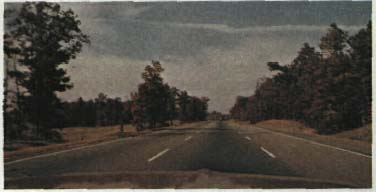
Tree masses on each side of the highway effectively balance the axial view in an asymmetrical manner.
A dominant element attracts attention to itself in a visual scene. A noise barrier should not be the dominant feature along a highway. Single dominance can be reduced through the introduction of other dominant elements which balance each other in the visual composition. Plantings in front of a barrier help to reduce visual dominance, particularly if the plantings are native varieties commonly found or present in an area. Color can also affect dominance. Brighter, contrasting colors make an object more dominant. Subdued, harmonious colors, similar to surrounding colors in intensity, tend to make an object less dominant. Wall design can also affect dominance of a noise barrier. Straight, high walls adjacent to the roadway appear imposing, an encroachment upon the space. Walls which step back in some way relieve this tight constricted feeling, and become less of a dominant element in the highway environment. Similar patterns of dominance occur on the residential side of barriers, with equally similar effects upon the resident.
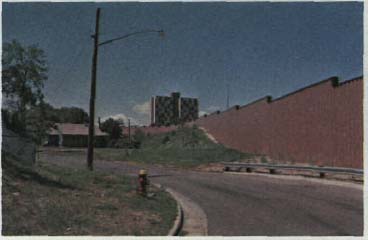
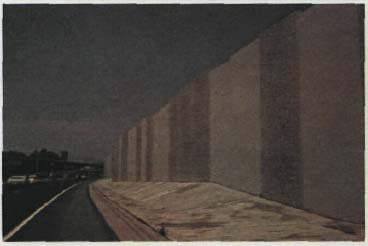
Dominant noise barriers
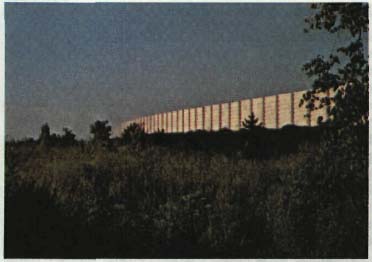
Bright colors tend to reflect light, and become more dominant.
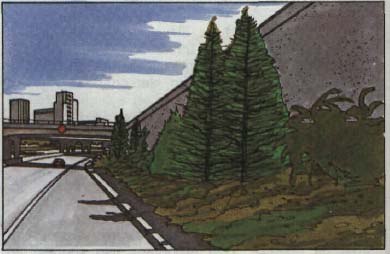
Plantings arranged in an informal manner to help to reduce the dominance of this wall.
The scale of a noise barrier should relate to the scale of the highway and the scale of the neighborhood into which it is placed. Scale relationships differ on each side of the barrier and must be treated independently. The highway scene is large scale - the view is often panoramic, one of open space, composed of both distant and close-up forms. Objects which register on this large scale panorama are bold, massive, and distinctive in line, form, color or texture. The noise barrier, as part of this large scale highway scene, should incorporate bold, massive elements in order to be consistent with the scale of the surrounding environment.
The pedestrian side of a barrier presents a different set of scale relationships. The pedestrian sees a barrier from a different perspective, not as part of a panoramic view, but often as the major dominant element of a small, confined scene. As such, the barrier appears exceptionally massive and overpowering. To reduce this impact, barrier elements must be of a more intimate, human scale. Textures, in particular, should be finer, detailed, and varied. Large masses cannot be appreciated by the observer unless viewed from a distance - pedestrians tend to concentrate on individual details rather than an entire composition. From the highway, details are lost to the moving observer - the view is composed of contrasting masses and spaces with less regard for individual components of the scene. As viewing distance increases, scale relationships change, which necessitates a corresponding change in the design treatment of structures in the landscape.
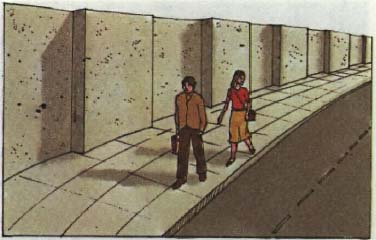
The scale of this wall tends to be overpowering to humans.
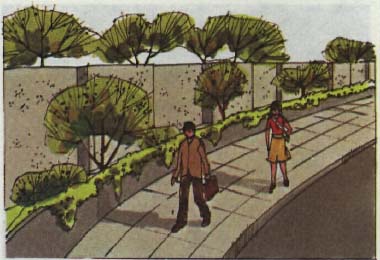
The scale of this wall relates better to pedestrians.
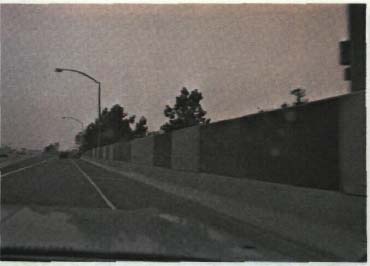
Details are lost to the moving observer.
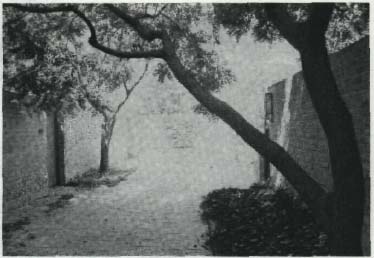
Details which can be appreciated by the pedestrian
The height and length of noise barriers is dictated by acoustical and site requirements. However, the proportions of the component parts may vary in order to achieve visual balance. The "golden section", a theorem developed by Pythagoras, involves the division of a line into two parts of which the first is to the second as the second is to the whole. This roughly translates to the ratios of 3:5 or 5:8. Spaces or masses proportioned by these ratios appear balanced and harmonious. These ratios may be applied to noise barriers in terms of wall setbacks, multiple wall height ratios, and in step down of walls for grade changes or termination. Similarly, the proportions of alternating wall panels or other height-length ratios should follow this relationship where possible. The dimensions of vertical elements, such as pilasters, should be balanced and in proportion to each other when used in combination with horizontal segments of a wall.
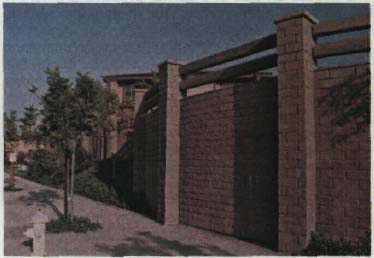
Good proportional relationships between vertical pilasters and horizontal elements in a wall
The position of the observer determines how much of a barrier is in view and the extent to which the barrier relates to other environmental components. A barrier is most likely to be negative in visual impact when the observer is relatively low compared to the top of the barrier. In this position, the barrier is most dominant, often blocking the view entirely. The viewing height from an automobile is approximately four feet (120 cm) above the pavement. The pedestrian eye level is approximately 5y 2 feet (170 cm) above the ground surface. From a moving perspective, a motorist has a minimum opportunity to observe design detail in elevation. A barrier is also viewed from two directions of travel on a highway and may appear different from each direction. The resident is more likely to view a barrier in elevation from a near perpendicular position, with consequent attention to detail. Consideration should be given, then, to the design of a highway noise barrier as it will appear in perspective, with the resultant effects of foreshortening, not just as it will appear in elevation. A proposed barrier should be examined at the position from which it will be viewed to determine if the desired visual effect will be achieved.
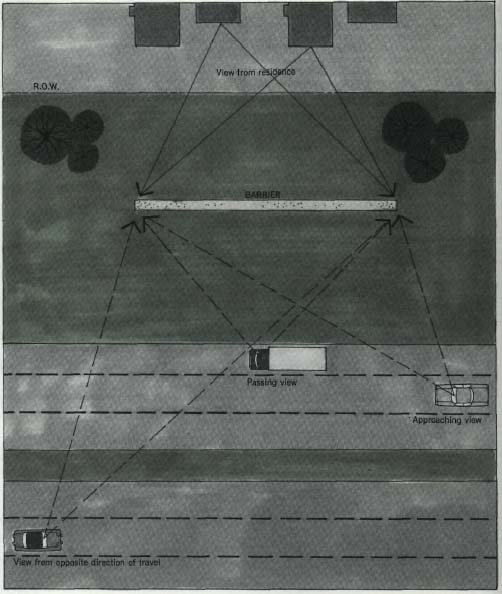
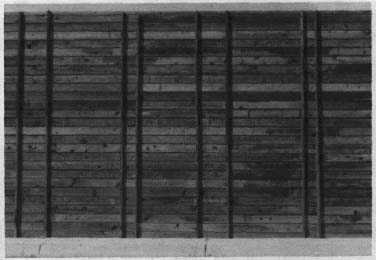
View of barrier in elevation
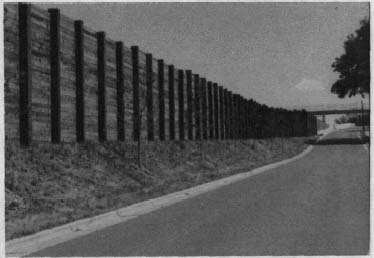
View of barrier in perspective. Note foreshortening effects: verticals seem to blend into a solid dark mass.
Atmospheric conditions may affect the visual impact of a noise barrier. Clear weather conditions promote maximum visibility and maximum contrast of colors. Precipitation in the form of rain, snow and fog reduce the effective viewing distance of an object and, therefore, the visual impact. A blanket of snow tends to obliterate or minimize horizontal forms in the environment and maximize the form of the vertical. A noise barrier is likely to have a high visual impact under this condition, particularly if it contrasts in color with the whites or grays of winter. In an area where snow covers the ground for a substantial portion of the year, the best color for a noise barrier might be a light gray in order to minimize contrast between it and the surroundings. The form of a noise barrier is likely to be most visible during the winter season when trees are bare and color in the landscape is at a minimum. A barrier may create unique visual situations during winter due to ice formations and drifting snow. Ledges and overhangs may produce ice formations which add to visual interest, and drifting snow along a wall or in pockets along a wall may help to reduce the apparent height. In areas of seasonal change, color variations in the landscape can be accompanied by color changes in a noise barrier through the use of plantings. Deciduous native plant materials that change color with the surrounding environment help to provide visual interest and relate a barrier to the landscape. Winter effect of plantings should be a consideration. Evergreens should be used where the primary function of the plantings is to provide year-round mass and texture. Perhaps the best solution is to specify groupings of both deciduous and evergreen plant materials. This provides both seasonal interest and year-round balance between a barrier and the environment.
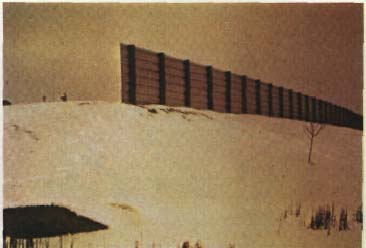
Contrast of barrier increased by snow conditions
Effect of change in sun angle on barrier lighting conditions
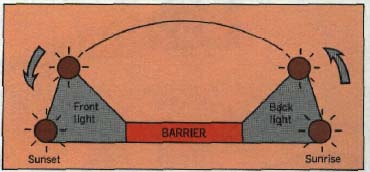
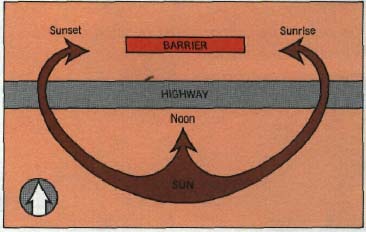
A barrier may appear different at various hours of the day due to the change in lighting conditions. The changing angle of the sun may produce back lighted, side-lighted, and front-lighted conditions on a barrier during the course of a single day. Back lighted barriers tend to be dominant mainly due to the increased awareness of form. This situation may be corrected through the use of a natural appearing tree line as a background for the distinctive form of the barrier. All but the coarsest of textures on a wall are subdued under this lighting condition. Therefore, barriers oriented to receive this type of light for the major portion of the day should employ the coarsest and boldest textures available if it is determined that texture is desirable. Colors, when placed in shadow, tend to appear darker; thus, lighter than normal colors should be utilized in walls where lightness is the objective. It is perhaps better to take advantage of a back-lighting condition, with its corresponding shadows and dark colors, as a means of reducing the visual awareness of a barrier. If a dark barrier is placed in front of a dark background of relatively taller trees, the barrier itself will tend to become invisible.
Side lighting produces maximum shadow effects on a noise barrier. Barriers which are likely to receive a majority of daylight from the side can achieve visual interest through rustication and other means of casting shadows to produce a three-dimensional effect. Trees placed to cast shadows on a barrier wall can impart a pleasant, ever-changing visual effect on an otherwise plain wall.
Barriers which are likely to be lighted from the front will appear to be brightest in color intensity; therefore, to avoid undesirable reflection of light, barrier colors should be somewhat darker.
Barriers which are front lighted also will appear flat and two-dimensional. Visual interest can be heightened through the use of color variations at transition points to intensify the awareness of the change in line. Trees placed in front of a barrier help to increase the feeling of depth which is lacking in a barrier wall lighted from the front. They also cast shadows on the wall.
Shadow effects vary through the year due to the change in height of the sun. In winter, the sun is lowest on the horizon, with a corresponding increase in length of shadows. In summer, the sun is highest in the sky, with shortest shadows as a result. This changing nature of lighting conditions should be considered by the designer when designing for shadow effect on noise barriers. The proposed effect may in fact be effective for only a small portion of the year.
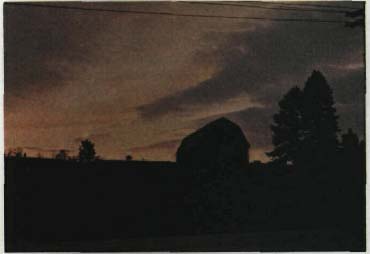
Back lighted objects are distinguishable by their form. Texture is difficult to perceive.
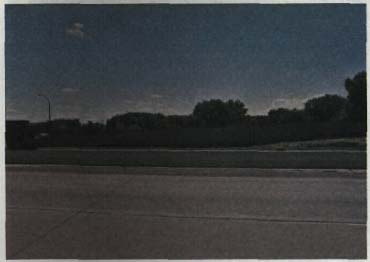
The line of this wall follows the natural tree line. When back lighted, the trees become the dominant form, rather than the wall.
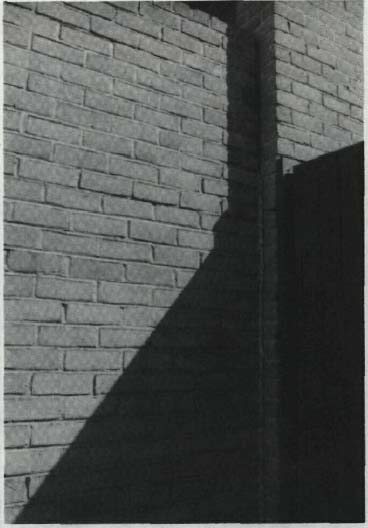
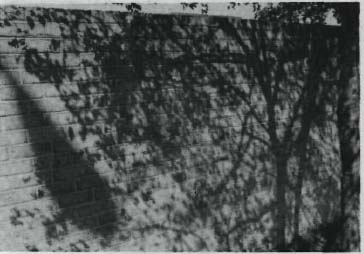
Shadow effects
A change in color or texture at transition points intensifies the awareness of the change.
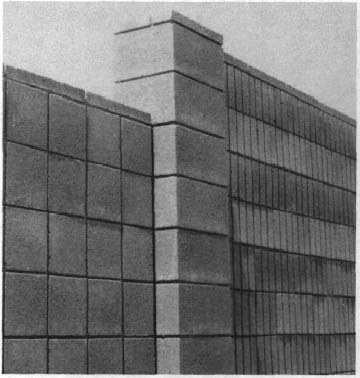
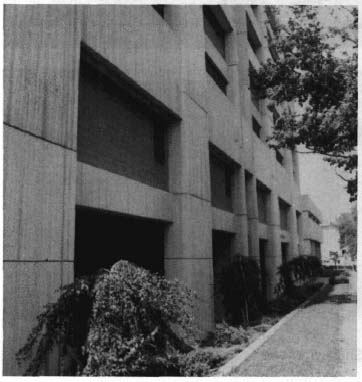
Change in color
The motorist is a moving observer, yet from an automobile, the apparent motion is not in the vehicle, but in the objects that line the roadway. At 60 miles per hour (96 km/hr), the observer is moving at 88 feet per second (27 m/sec). It has been determined that objects placed the same distance from the road as the viewing speed in miles per hour will appear blurred to the driver. At 60 miles per hour (96 km/hr), then, all objects placed within 60 feet (18 m) of the driving lane will appear blurred. Objects in the foreground move most rapidly, and may even tend to disappear. Objects that are of medium distance from the road, approaching the equivalent speed in distance, are just beginning to blur. Distant objects are the only distinctly visible components of the view which the motorist can observe in detail and at leisure. Fine detail in a noise barrier which is to be viewed by the motorist is unnecessary. A barrier will occupy space in the foreground or middle ground of the overall highway scene; in this position, barrier details become a blur to the motorist.
The peripheral vision of a motorist is related to speed. As speed increases, the eye unconsciously tends to narrow its field of vision in order to concentrate on the road ahead. Objects which are outside of this limit of peripheral vision are vague, particularly if they are low in contrast with their surroundings. Objects that are of high contrast at this limit of vision tend to attract the eye and distract the attention from the roadway. Noise barriers, as objects along the roadway, should not distract the attention of the motorist. Barriers with high contrast, particularly those which repeat a series of contrasting colors, should be avoided. Flickers of light, caused by contrasting colors, repetitive tree plantings or other means, can result in driver annoyance and distraction.
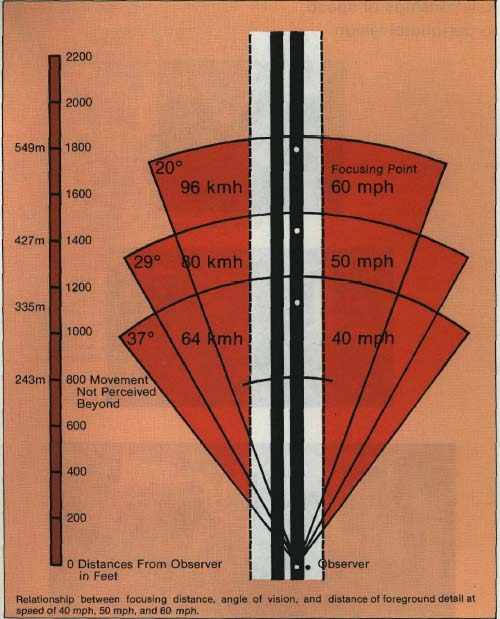
Relationship between focusing distance, angle of vision, and distance of foreground detail at speed of 40 mph, 50 mph, and 60 mph.
Relationships of speed to peripheral vision
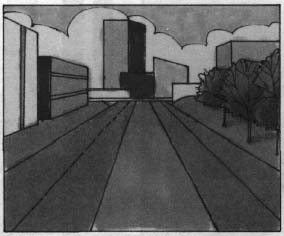
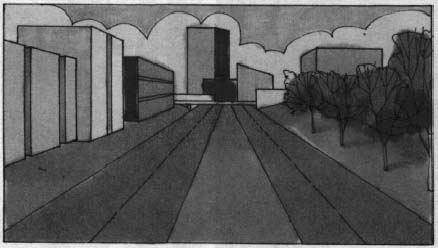
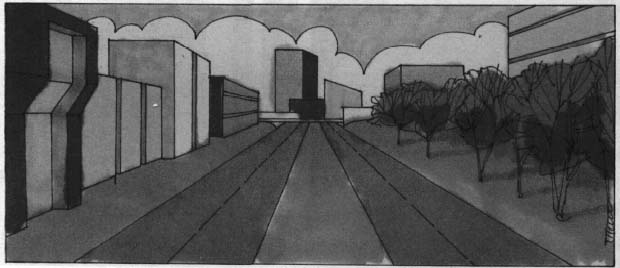
The pedestrian is a slowly moving or stationary observer. While walking, one averages a speed of 2½ miles per hour. At this speed, peripheral vision approaches 180 degrees, and the observer has the opportunity to turn his head and concentrate on any object which is of interest without seriously affecting forward movement. In fact, one is often free to stop and examine objects closely. The pedestrian, then, is more likely to see and appreciate detail in a noise barrier and to enjoy the experience of moving slowly past a barrier which incorporates a change in visual interest.
The resident who lives adjacent to a noise barrier views the barrier as a static element in the visual scene. There is little or no motion involved in viewing the barrier, and no opportunity for sequential change in the perception of the barrier in its entirety. As a static element, the noise barrier should provide visual interest in the form of detailed textures, complemented by the interesting arrangement and combination of plantings which are of interest in themselves.
A noise barrier can and should provide visual interest for the observer, regardless of the speed of the observer or the position from which it is viewed. This can be accomplished by consideration for the separate, and distinctly different, viewing situations which accompany the placement of a noise barrier in the environment. The designer must consider the visual needs of the motorist, the pedestrian, and the resident as unique and separate elements that require separate design treatment.